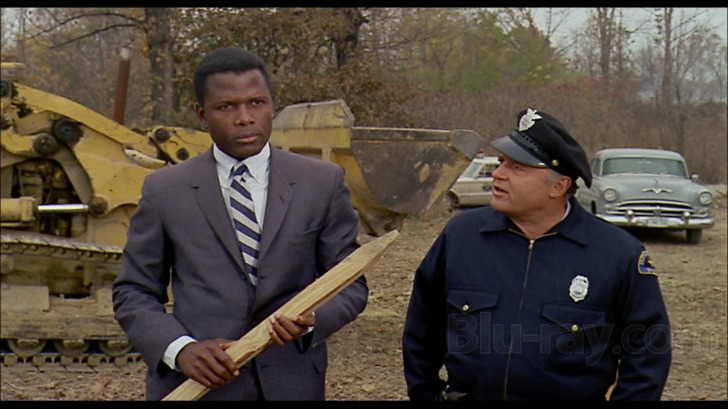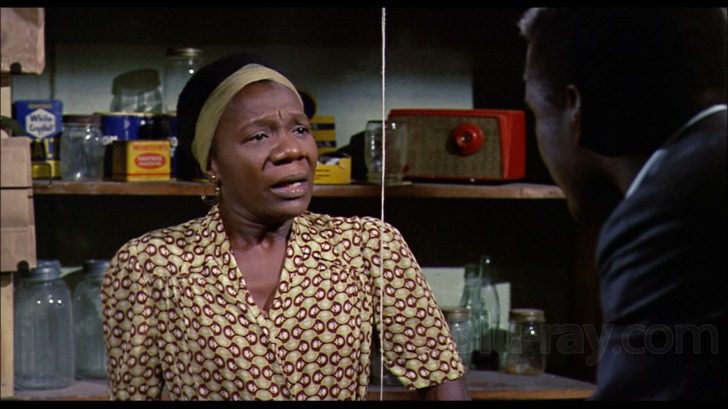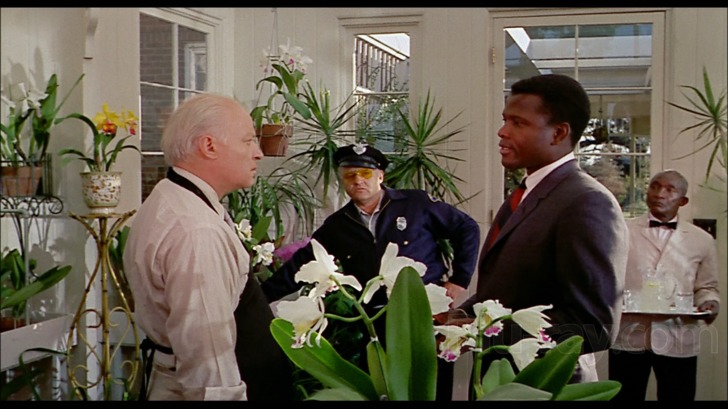In the Heat of the Night Blu-ray Movie
HomeIn the Heat of the Night Blu-ray Movie 
Metro-Goldwyn-Mayer | 1967 | 110 min | Not rated | Jan 14, 2014
Movie rating
8.1 | / 10 |
Blu-ray rating
| Users | 4.8 | |
| Reviewer | 4.0 | |
| Overall | 4.2 |
Overview
In the Heat of the Night (1967)
An African American police detective is asked to investigate a murder in a racially hostile southern town.
Starring: Sidney Poitier, Rod Steiger, Warren Oates, Lee Grant, Larry GatesDirector: Norman Jewison
| Film-Noir | 100% |
| Drama | 88% |
| Thriller | Insignificant |
| Crime | Insignificant |
| Mystery | Insignificant |
Specifications
Video
Video codec: MPEG-4 AVC
Video resolution: 1080p
Aspect ratio: 1.85:1
Original aspect ratio: 1.85:1
Audio
English: DTS-HD Master Audio 5.1 (48kHz, 24-bit)
French: DTS-HD Master Audio Mono
Italian: DTS-HD Master Audio Mono
Japanese: DTS-HD Master Audio Mono
Spanish: Dolby Digital Mono
Spanish: DTS-HD Master Audio Mono
German: DTS 2.0
Portuguese: Dolby Digital Mono
Subtitles
English SDH, French, German, Italian, Japanese, Portuguese, Spanish, Greek
Discs
50GB Blu-ray Disc
Single disc (1 BD)
Playback
Region A, B (C untested)
Review
Rating summary
| Movie | 4.5 | |
| Video | 4.0 | |
| Audio | 4.0 | |
| Extras | 3.0 | |
| Overall | 4.0 |
In the Heat of the Night Blu-ray Movie Review
They Still Call Him Mr. Tibbs
Reviewed by Michael Reuben January 13, 2014Nearly fifty years after the release of In the Heat of the Night (hereafter "ItHotN"), it may be almost impossible for new viewers to appreciate the impact of the film's images on contemporary viewers. The country was still in the thick of the Sixties' civil rights movement; indeed, the Oscar ceremony at which the film would receive five awards, including Best Picture, was delayed for two days following the assassination of Dr. Martin Luther King, Jr. on April 4, 1968. Just three years before ItHotN filled American movie screens with scenes of a small town Mississippi police force staffed by bigots, the media were saturated with stories of three young civil rights workers, Goodman, Chaney and Schwerner, abducted and murdered by Klansmen and members of the Neshoba County, Mississippi sheriff's department. When the fictional Southern officers falsely arrested an "uppity" black cop from the north, everyone in the audience immediately felt the "heat" of the title. In an instantly famous scene later in the film, when the black cop actually slapped the town's leading citizen, audiences were stunned. Nothing like this had ever been seen in a mainstream Hollywood movie. Everyone could identify with the sentiment of Police Chief Gillespie, who, when asked what he intended to do about the slap, simply answered, "I don't know." ItHotN may no longer be as explosively topical today, but it's still an absorbing entertainment fueled by powerhouse performances from Rod Steiger (who won the Best Actor Oscar as Gillespie) and Sydney Poitier, based on an ingenious script by Stirling Silliphant (another Oscar winner) adapting a novel by John Ball, crisply edited by future director Hal Ashby (yet another Oscar) and sharply directed by Norman Jewison (who was nominated for Best Director but lost to Mike Nichols for The Graduate). The film also won an Oscar for sound, which probably should have been for its jazz/blues musical score by Quincy Jones that gave its soundtrack a quality unlike any other motion picture being released at the time. The music provided a sense of authenticity, even though, for reasons of safety, the film had to be shot almost entirely in Illinois.

The brilliance of Silliphant's script is that it manages to wind so many elements around the simple core of that most basic device, the police procedural. A body is found in the streets of Sparta, Mississippi. He was Mr. Colbert, a wealthy industrialist from Chicago, who was planning to build a factory that would bring much-needed jobs to this sleepy town, but someone bludgeoned him to death. Deputy Sam Wood (Warren Oates) thinks he has a likely suspect when he finds a well-dressed African-American man waiting for a train with far more money in his wallet than Deputy Sam thinks any "colored" should have. Only after Sam has hauled the man in before Chief Gillespie (Steiger) is he revealed to be a Philadelphia homicide detective, Virgil Tibbs (Poitier). Despite instant antipathy between Gillespie and Tibbs, the northerner stays to assist in the investigation—at first, because his chief in Philadelphia orders him to, then because the victim's grieving widow (Lee Grant) insists that he be kept on the case, because he's the only one who seems to know what he's doing. The loss of this important investor, combined with the presence of a self-possessed black policeman from the outside, unsettles the town and opens windows into every corner of Sparta, high and low. Most of the people seen through those windows aren't friendly. Indeed, the politically savvy Mayor Schubert (distinguished character actor William Schallert) quietly counsels Chief Gillespie to let Tibbs be his stalking horse and take the blame for anything that goes wrong. Mrs. Colbert and her late husband's staff point the finger at Eric Endicott (Larry Gates), a cotton farmer and Sparta's local royalty, who opposed Colbert's factory. It isn't hard to imagine why, when Tibbs and Gillespie drive through endless cotton fields where time seems to have stood still as black field hands harvest Endicott's crop by hand. Colbert's plant might have offered better-paying jobs to many of these workers. Forensic evidence suggests that Colbert visited Endicott shortly before he died, which prompts the visit by the two police officers to the plantation-style manner where the old man lives. The encounter begins civilly enough but quickly degenerates into the famous exchange of slaps between Endicott and Tibbs. (Endicott strikes first.) No matter how many times I see the film, I notice something new in Chief Gillespie's reaction. It's one of the most layered responses you'll ever see on film. Despite Endicott's obvious motive, the Colbert case keeps taking odd turns: the victim's wallet in the possession of a known felon, an unusually large bank deposit the morning after the murder, or a quirk in Deputy Sam's patrol route. Meanwhile, local sentiment against Tibbs is rising to the point of action, especially after the Endicott encounter. Time is running out. As mismatched as Tibbs and Gillespie may be, Poitier and Steiger make a spectacular screen pairing. Poitier remains steely-eyed and precise, as his character would have to be in that situation, while Steiger is operatic and as uncontrolled as the belly that constantly juts over Gillespie's belt. Steiger was famous for going over the top, and on the disc's commentary track, director Jewison talks about constantly pulling him back, while Steiger insists that taking chances is the only way to achieve something worthwhile. Whoever is right, the role of Gillespie was a perfect fit for Steiger. Much of the Chief's law enforcement technique relies on an excess of personality. He does and says everything in a big, loud way, so that people are afraid to cross him. And just when you think Gillespie is all bully and bluster, Steiger surprises you with the Chief's native intelligence and shrewdness about people. (The scene at the train station where he persuades Tibbs to stay and solve the case is a masterpiece.) He's smart enough to accept Tibbs's deductive conclusions, when they make sense, and to question them when they're based on something other than logic. "Man, you're just like the rest of us", Gillespie whispers in wonderment, when Tibbs gets too eager to build a case against Endicott, just because he's a bigoted fat cat. Tibbs and Gillespie don't become friends over the course of ItHotN, but they do learn a little about each other and even more about themselves. It's just enough for them to part on civil terms at the end. That, too, was a radical sight in 1967.
In the Heat of the Night Blu-ray Movie, Video Quality 

In his commentary/interview, cinematographer Haskell Wexler discusses the challenges, and describes some of the strategies he employed, in lighting the many dark locations for In the Heat of the Night, given the slow film stocks of the era. The result, as reproduced on Fox/MGM's 1080p, AVC-encoded Blu-ray, is a richly textured and colorful image, but many Blu-ray fans will be dissatisfied with it, as is so often the case with classic films from this era. Before home video, viewers went to the theater, sat in their seats and watched the story and the characters; they didn't worry about grain, softness or degree of detail, and they certainly didn't freeze the image to flyspeck its quality frame by frame. ItHotN looks exceptionally good for a film from 1967. The elements are in excellent shape (or have been well-restored), with almost no evident damage or degeneration. The image is soft but detailed, with an evident but natural grain structure. The colors are especially vivid and varied, with the strongest reds and blues I can recall in any home video version of the film. The shadows of night are solidly black, which is critical to how Wexler's visual design directs the eye, especially in the opening sequence depicting Tibbs's arrival in Sparta and the explosive confrontation that serves as the film's climax. The film doesn't have much in the way of fast action, but the relatively high average bitrate of 32.82 Mbps is appropriate for proper handling of the grain structure. Nothing has been lost or compromised in compression. Complaints are inevitable that the review's video score is too high and/or that the Blu-ray looks like an upconverted DVD. This is unavoidable in a world where too many eyes are no longer familiar with the look of film, especially film from an earlier era. I was around when ItHotN was new, and this is a fine rendition. Additional note: I have been advised that this master was taken from a dupe negative derived from separation elements, but the dupe negative was created by analog scanning, which routinely results in a degree of misalignment. Therefore, a certain amount of instability was baked into the dupe negative, which is the main reason why much of the background detail in the Blu-ray image appears indistinct. The effect is similar to what 1967 audiences probably saw after the print at their local cinema had been run through the projector for a week or so. Some posters in the Blu-ray.com forum have attributed this phenomenon to digital manipulation, but in fact it's an accurate reflection of what is on the negative as it currently exists. Had MGM invested the time and money, the instability in the dupe negative could have been substantially reduced for Blu-ray. Contemporary software tools allow the three separation layers to be disassembled digitally, then reassembled with greater precision, resulting in a sharper image than was probably available to many original viewers in 1967. Perhaps, at some future date, either MGM or a third party will allocate the budget for such a restoration. The important point, however, is that any perceived instability in the image does not result from digital tampering but almost certainly the opposite: a lack of digital repair.
In the Heat of the Night Blu-ray Movie, Audio Quality 

The film's original mono soundtrack has been remixed for 5.1, presented here in lossless DTS-HD MA. Like most good remixes of mono tracks, it's a front-oriented mix that provides additional clarity and definition by directing the vocals and effects to the center and allowing the musical score to expand to the left and right. Quincy Jones's wonderful score sounds better than ever, although the dynamic range is somewhat limited by the original source. It's a minor but noticeable improvement on the mono mix, and those who insist on 5.1 can comfort themselves that they're getting a remix.
In the Heat of the Night Blu-ray Movie, Special Features and Extras 

MGM first released In the Heat of the Night on DVD in 2001 with a commentary and trailer. The 2008 "40th Anniversary Collector's Edition" added three featurettes. All of those extras have been ported over to the Blu-ray. As per their usual user-unfriendly practice with MGM catalog titles, Fox Home Video has formatted the disc with BD-Java, no main menu and no bookmarking to allow the viewer to stop and resume at the same point.
- Commentary with Director Norman Jewison, Director of Photography Haskell Wexler and Actors Rod Steiger and Lee Grant: Rather than a traditional scene-specific commentary, this is a series of four separate interviews, edited and intercut together. Since the track first appeared in 2001, and Jewison indicates that he had recently finished The Hurricane (1999), the interviews probably were taken in 2000. Jewison has the largest amount of air time, followed by Wexler, then Steiger and Grant. Grant describes how she created Mrs. Colbert with only a limited time on screen. Steiger recounts his first reaction to the character of Gillespie, which was unfavorable, and his growing interest in such details as the character's incessant gum-chewing; he also tells interesting tales from the set. Wexler describes his innovative solutions for lighting the film's locations and also speaks fervently about the importance of remembering our history. Finally, Jewison ranges widely over every aspect of the film, including its reception.
- Turning up the Heat: Movie-Making in the 60's (480i; 1.78:1, enhanced; 21:10): A diverse group of interview subjects discuss the place of ItHotN in American movies and history. The participants include Jewison; Wexler; producer Walter Mirisch; director John Singleton; Reginald Hudlin, a director and president of Black Entertainment Television; Dr. Imani Perry of Princeton University; Dr. Todd Boyd of USC; Patricia King Hanson, an AFI film historian; and composer Quincy Jones.
- The Slap Heard Round the World (480i; 1.78:1, enhanced; 7:25): Many of the same participants in "Turning up the Heat" return with observations about the famous confrontation between Tibbs and Endicott.
- Quincy Jones: Breaking New Sound (480i; 1.78:1, enhanced; 13:02): Quincy Jones, Jewison, musician Herbie Hancock and others discuss the soundtrack for ItHotN. Also interviewed are Alan and Marilyn Bergman, who wrote the lyrics for the title track sung by Ray Charles and for all the pops songs used as source music, because it was cheaper to have Jones write original songs than pay royalties for existing tunes.
- Theatrical Trailer (1080p; 1.85:1; 2:48): The trailer is in rough shape and appears to be from a low-resolution source, despite the 1080p formatting.
In the Heat of the Night Blu-ray Movie, Overall Score and Recommendation 

Steiger's Gillespie is one of the great screen characters of modern cinema. He's loud, annoying, a bully, often a buffoon, and racism is bred into his DNA—and yet you can't take your eyes off him. Repeatedly throughout ItHotN, Gillespie exceeds the sum of his cliches to become, if only for a moment, something more than the stereotypical redneck cop that everyone assumes he'll be when he first appears. Of all the radical elements in the film, the most unexpected may have been making a hero out of someone whose look recalled the notorious Bull Connor of Birmingham, Alabama, or the sheriff and deputies indicted for killing Goodman, Chaney and Schwerner. As the best stories do, ItHotN found a core of humanity in the least likely place, which is yet another reason why it still holds up. Highly recommended.
Other editions
In the Heat of the Night: Other Editions

In the Heat of the Night
Awards O-Ring Slipcover
1967

In the Heat of the Night
1967

In the Heat of the Night 4K
1967
Similar titles
Similar titles you might also like

Phantom Lady
1944

Where the Sidewalk Ends
Limited Edition to 3000 - SOLD OUT
1950

On Dangerous Ground
Warner Archive Collection
1951

Boomerang
1947

The Crimson Kimono
Limited Edition to 3000
1959

Crossfire
Warner Archive Collection
1947

Double Indemnity 4K
1944

I Confess
Warner Archive Collection
1953

The Killers
1946

Devil in a Blue Dress 4K
1995

Kiss Me Deadly
1955

The Big Heat
Encore Edition | Limited Edition to 3000 - SOLD OUT
1953

Hustle
1975

Bullitt
1968

The Shadow on the Window
1957

The Blue Dahlia
1946

Whirlpool
Limited Edition to 3000
1949

In a Lonely Place
1950

Blue Velvet 4K
1986

The Black Dahlia
2006